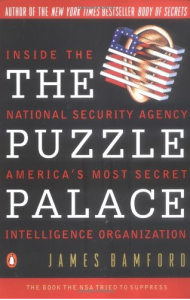 James Bamford has a long description at the Intercept of how he started writing long exposes of the NSA’s lawless spying.
James Bamford has a long description at the Intercept of how he started writing long exposes of the NSA’s lawless spying.
Having been assigned to an NSA unit during Vietnam, he learned the NSA intercepted American communications during a later two week Reserve stint at NSA’s Puerto Rican listening post. When the NSA claimed to have shut that down to the Church Committee, Bamford secretly corrected that false claim with the Senate.
That led him to a relentless hunt for more details of what the NSA did. Among his discoveries, he obtained DOJ’s investigative file into the many illegal programs of the agency.
That’s when things started to get interesting.
Bamford had obtained that file under FOIA during the Carter Administration. But when Ronald Reagan put William French Smith in charge at DOJ, the Department decided to try to get that document back.
Bamford describes how he managed to publish his book, The Puzzle Palace, anyway — by using methods still used as journalists try to expose the NSA!
For example, as the Guardian did in 2013, Bamford did in 1981, getting a copy of the document sent overseas for safe-keeping from black bag jobs and other government interference.
My first thought was to quickly make a duplicate of the file and get the copy out of the country. That would protect the documents not only from theft, but also from any court order prohibiting me from revealing their contents. With a copy beyond the jurisdiction of U.S. courts, a foreign newspaper could always publish the documents.
I called a close friend who worked for the Insight Team, the investigative unit of London’s Sunday Times. She agreed to help. It turned out that an American journalist she knew was flying from Boston to London that night, and she quickly arranged for him to take the documents with him and give them to her to hide.
That night I met the journalist on a dark Boston street corner and passed him a package, with the understanding that I was not to tell him what it contained. He wanted as little information as possible, in case he was questioned later. Early the next morning, my friend at the Sunday Times called from London with a code indicating that all was well and that the documents were in a secure place.
And as happened with Thomas Drake when the government was trying to prosecute him for having unclassified documents in a box in his basement, among others, the government tried to criminalize whistleblowing and reporting by retroactively classifying documents.
On September 24, after we informed Schroeder that I was going to use the documents in my book and that all further discussions would be pointless, I received a registered letter. “You are currently in possession of classified information that requires protection against unauthorized disclosure,” Schroeder wrote. “Under the circumstances, I have no choice but to demand that you return the two documents . . . Of course, you will have a continuing obligation not to publish or communicate the information.” To emphasize the point, on November 27 the Justice Department sent my attorney a letter stating that “there should be no misunderstanding of the Government’s position that Mr. Bamford holds information that is currently and properly classified” and that failure to return the documents could force federal prosecutors to resort to an unnamed “post-publication judicial remedy.”
Despite the threats, I refused to alter my manuscript or return the documents. Instead, we argued that according to Executive Order 12065, “classification may not be restored to documents already declassified and released to the public” under the Freedom of Information Act. That prompted the drama to move all the way up to the White House. On April 2, 1982, President Reagan signed a new executive order on secrecy that overturned the earlier one and granted him the authority to “reclassify information previously declassified and disclosed.”
We responded by citing the legal principle of ex post facto, arguing that even if the new executive order was legal, Reagan could not retroactively enforce it against me. The Puzzle Palace was published on schedule, in September 1982, with no deletions or alterations to the text.
Thankfully, Bamford resisted this bullying, revealing No Such Agency to the world.
Still — it’s a pity we’re still fighting the same battles and using the same tactics to try to understand what kind of spying our government does on us.


